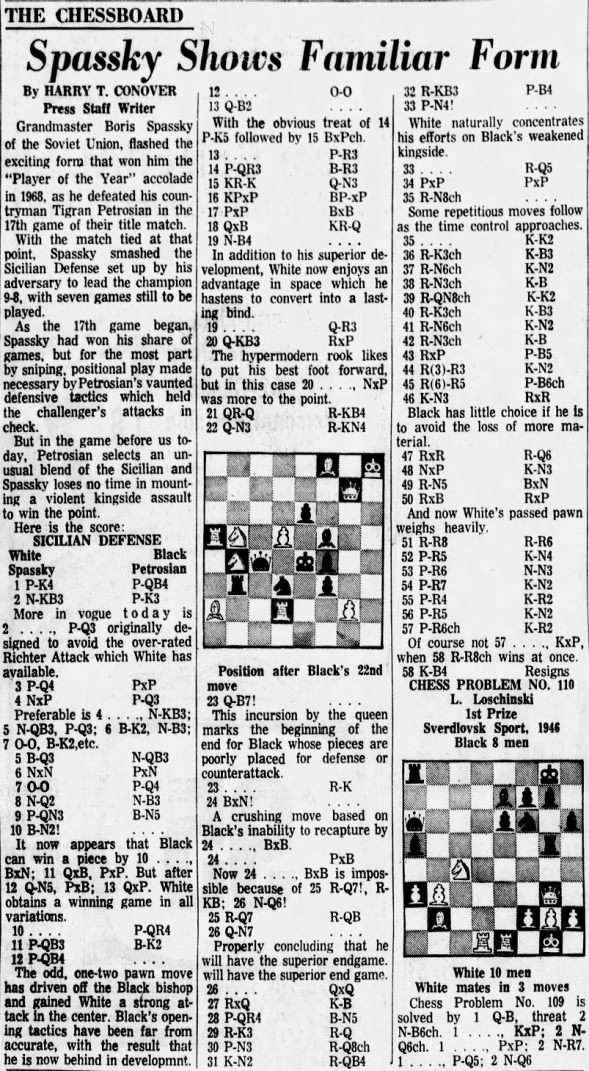 The Chessboard 22 Jun 1969, Sun Asbury Park Press (Asbury Park, New Jersey) Newspapers.com
The Chessboard 22 Jun 1969, Sun Asbury Park Press (Asbury Park, New Jersey) Newspapers.com
The Chessboard: Spassky Shows Familiar Form by Harry T. Conover
Grandmaster Boris Spassky of the Soviet Union, flashed the exciting form that won him the “Player of the Year” accolade in 1968, as he defeated his countryman Tigran Petrosian in the 17th game of their title match.
With the match tied at that point, Spassky smashed the Sicilian Defense set up by his adversary to lead the champion 9-8, with seven games still to be played.
As the 17th game began, Spassky had won his share of games, but for the most part by sniping, positional play made necessary by Petrosian's vaunted defensive tactics which held the challenger's attacks in check.
But in the game before us today, Petrosian selects an unusual blend of the Sicilian and Spassky loses no time in mounting a violent kingside assault to win the point.
Here is the score:
Boris Spassky vs Tigran V Petrosian
Petrosian - Spassky World Championship Match (1969), Moscow URS, rd 17, May-28
Sicilian Defense: Kan. Modern Variation (B42) 1-0
1. e4 c5 2. Nf3 e6
More in vogue today is 2. … P-Q3 originally designed to avoid the over-rated Richter Attack which White has available.
3. d4 cxd4 4. Nxd4 a6
Preferable is 4. … N-KB3; 5. N-QB3 P-Q3; 6. B-K2 N-B3; 7. O-O B-K2, etc.
5. Bd3 Nc6 6. Nxc6 bxc6 7. O-O d5 8. Nd2 Nf6 9. b3 Bb4 10. Bb2!
It now appears that Black can win a piece by 10. … BxN; 11. QxB PxP. But after 12. Q-N5 PxB; 13. QxP. White obtains a winning game in all variations.
10. … a5 11. c3 Be7 12. c4
The odd, one-two pawn move has driven off the Black bishop and gained White a strong attack in the center. Black's opening tactics have been far from accurate, with the result that he is now behind in development.
12. … O-O 13. Qc2
With the obvious treat of 14. P-K5 followed by BxPch.
13. … h6 14. a3 Ba6 15. Rfe1 Qb6 16. exd5 cxd5 17. cxd5 Bxd3 18. Qxd3 Rfd8 19. Nc4
In addition to his superior development, White now enjoys an advantage in space which he hastens to convert into a lasting bind.
19. … Qa6 20. Qf3 Rxd5
The hypermodern rook likes to put his best foot forward, but in this case 20. … NxP was more to the point.
21. Rad1 Rf5 22. Qg3 Rg5
23. Qc7!
This incursion by the queen marks the beginning of the end for Black whose pieces are poorly placed for defense or counterattack.
23. … Re8 24. Bxf6!
A crushing move based on Black's inability to recapture by 24. … BxB.
24. … gxf6
Now 24. … BxB is impossible because of 25. R-Q7! R-KB; 26. N-Q6!
25. Rd7 Rc8 26. Qb7
Properly concluding that he will have the superior endgame.
26. … Qxb7 27. Rxb7 Kf8 28. a4 Bb4 29. Re3 Rd8 30. g3 Rd1+ 31. Kg2 Rc5 32. Rf3 f5 33. g4!
White naturally concentrates his efforts on Black's weakened kingside.
33. … Rd4 34. gxf5 exf5 35. Rb8+
Some repetitious moves follow as the time control approaches.
35. … Ke7 36. Re3+ Kf6 37. Rb6+ Kg7 38. Rg3+ Kf8 39. Rb8+ Ke7 40. Re3+ Kf6 41. Rb6+ Kg7 42. Rg3+ Kf8 43. Rxh6 f4 44. Rgh3 Kg7 45. R6h5 f3+ 46. Kg3 Rxh5
Black has little choice if he is to avoid the loss of more material.
47. Rxh5 Rd3 48. Nxa5 Kg6 49. Rb5 Bxa5 50. Rxa5 Rxb3
And now White's passed pawn weighs heavily.
51. Ra8 Ra3 52. a5 Kg5 53. a6 Kg6 54. a7 Kg7 55. h4 Kh7 56. h5 Kg7 57. h6+ Kh7
Of course not 57. … KxP when 58 R-R8ch wins at once.
58. Kf4 Resigns
Chess Problem No. 110 by L. Loschinski, 1st Prize, Sverlovsk Sport, 1946. White mates in 3 moves.
FEN r5k1/4bpp1/q3pn1p/p5r1/2N5/PP4Q1/1B3PPP/3RR1K1 w - - 0 1
Key: N-B2?!!
 TV: Chess 29 Jun 1969, Sun Asbury Park Press (Asbury Park, New Jersey) Newspapers.com
TV: Chess 29 Jun 1969, Sun Asbury Park Press (Asbury Park, New Jersey) Newspapers.com























